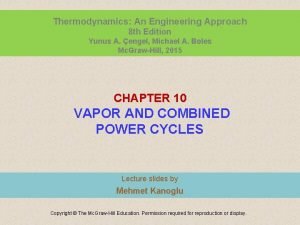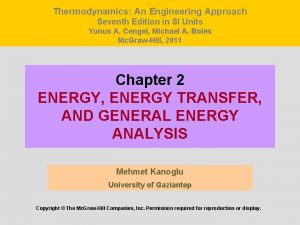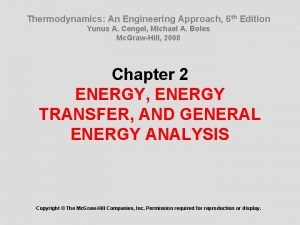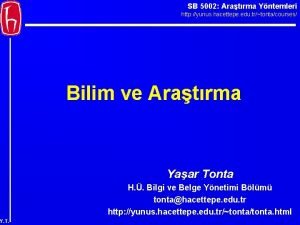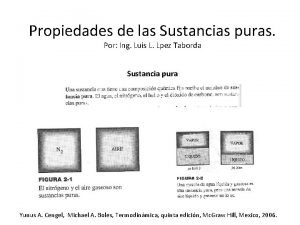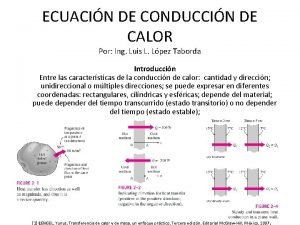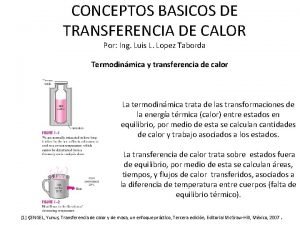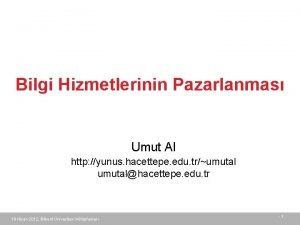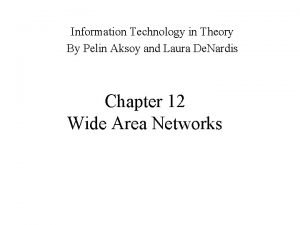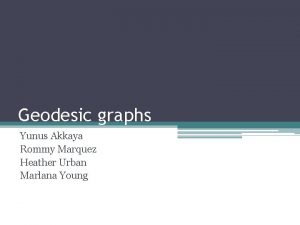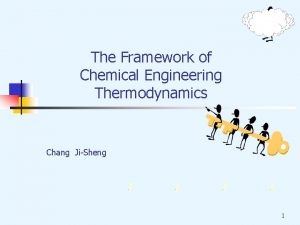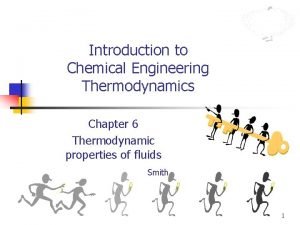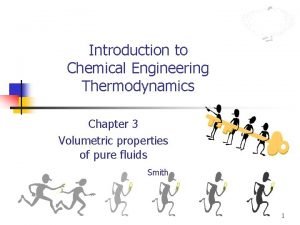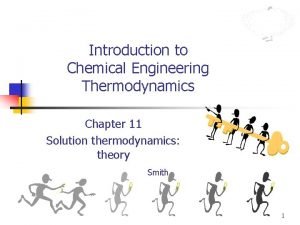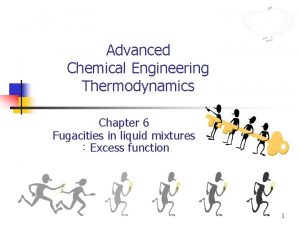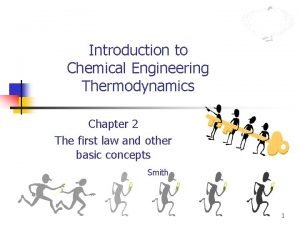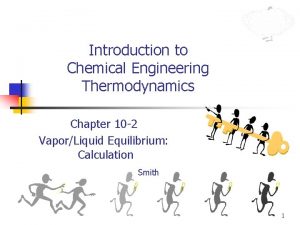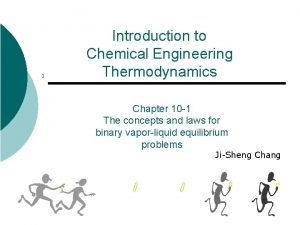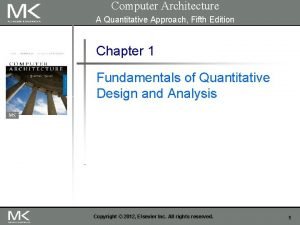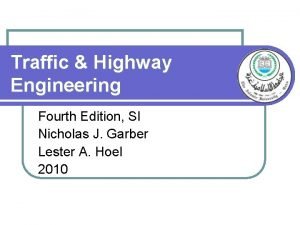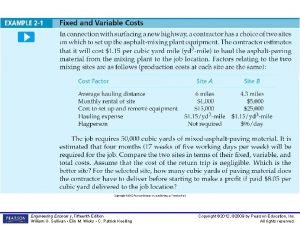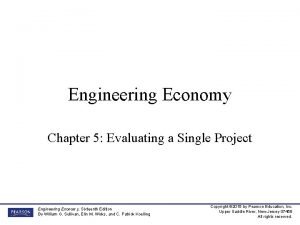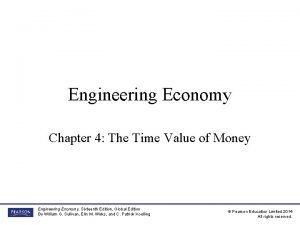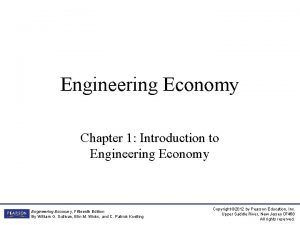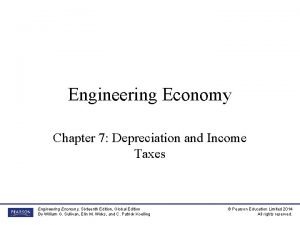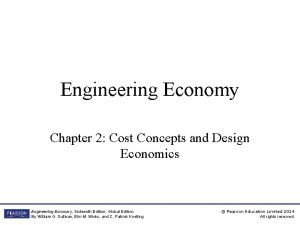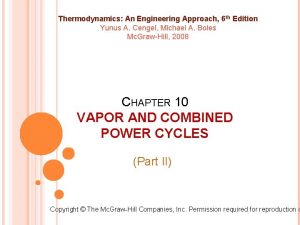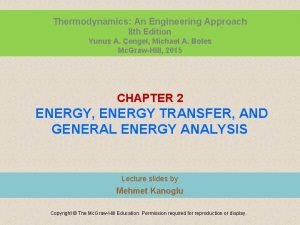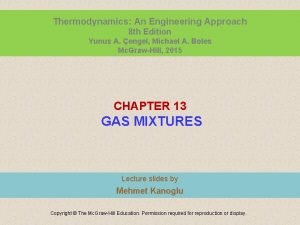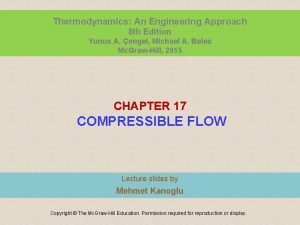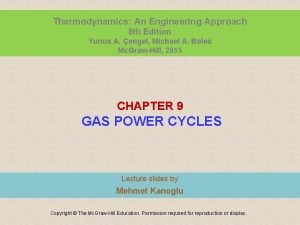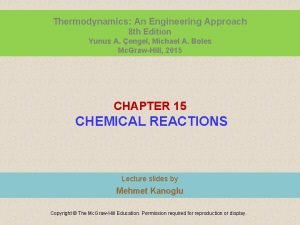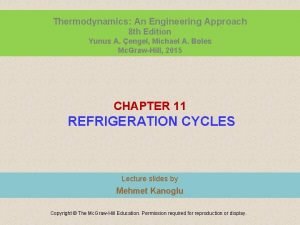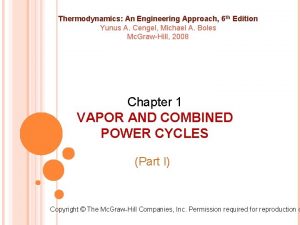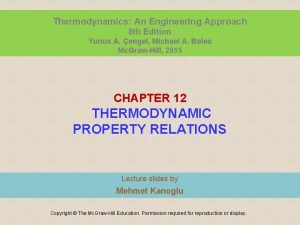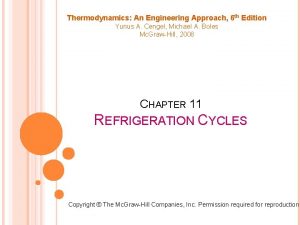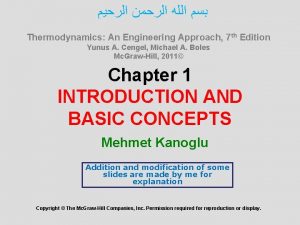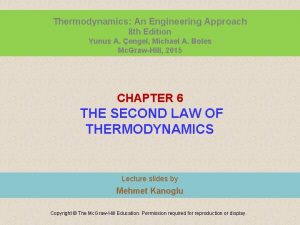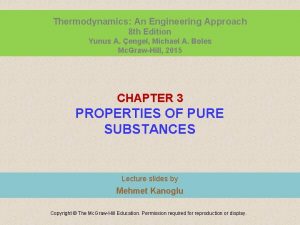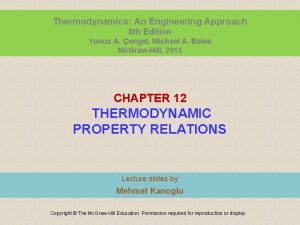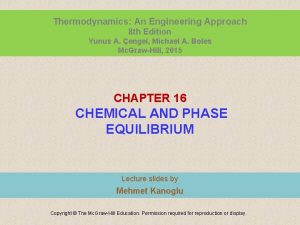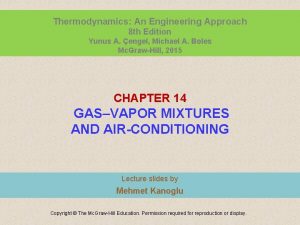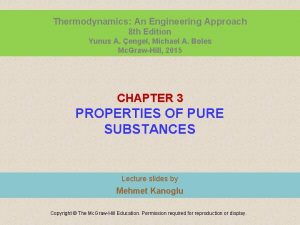Thermodynamics An Engineering Approach 8 th Edition Yunus













































- Slides: 45

Thermodynamics: An Engineering Approach 8 th Edition Yunus A. Çengel, Michael A. Boles Mc. Graw-Hill, 2015 CHAPTER 7 ENTROPY Lecture slides by Mehmet Kanoglu Copyright © The Mc. Graw-Hill Education. Permission required for reproduction or display.

Objectives • Apply the second law of thermodynamics to processes. • Define a new property called entropy to quantify the secondlaw effects. • Establish the increase of entropy principle. • Calculate the entropy changes that take place during processes for pure substances, incompressible substances, and ideal gases. • Examine a special class of idealized processes, called isentropic processes, and develop the property relations for these processes. • Derive the reversible steady-flow work relations. • Develop the isentropic efficiencies for various steady-flow devices. • Introduce and apply the entropy balance to various systems. 2

ENTROPY Clasius inequality Formal definition of entropy The equality in the Clausius inequality holds for totally or just internally reversible cycles and the inequality for the irreversible ones. 3

A quantity whose cyclic integral is zero (i. e. , a property like volume) Entropy is an extensive property of a system. A Special Case: Internally Reversible Isothermal Heat Transfer Processes This equation is particularly useful for determining the entropy changes of thermal energy reservoirs. 4

THE INCREASE OF ENTROPY PRINCIPLE The equality holds for an internally reversible process and the inequality for an irreversible process. Some entropy is generated or created during an irreversible process, and this generation is due entirely to the presence of irreversibilities. The entropy generation Sgen is always a positive quantity or zero. Can the entropy of a system during a process decrease? 5

The increase of entropy principle 6

Some Remarks about Entropy 1. Processes can occur in a certain direction only, not in any direction. A process must proceed in the direction that complies with the increase of entropy principle, that is, Sgen ≥ 0. A process that violates this principle is impossible. 2. Entropy is a nonconserved property, and there is no such thing as the conservation of entropy principle. Entropy is conserved during the idealized reversible processes only and increases during all actual processes. 3. The performance of engineering systems is degraded by the presence of irreversibilities, and entropy generation is a measure of the magnitudes of the irreversibilities during that process. It is also used to establish criteria for the performance of engineering devices. 7

ENTROPY CHANGE OF PURE SUBSTANCES Entropy is a property, and thus the value of entropy of a system is fixed once the state of the system is fixed. Entropy change 8

ISENTROPIC PROCESSES A process during which the entropy remains constant is called an isentropic process. 9

PROPERTY DIAGRAMS INVOLVING ENTROPY On a T-S diagram, the area under the process curve represents the heat transfer for internally reversible processes. Mollier diagram: The h-s diagram 10

11

WHAT IS ENTROPY? Boltzmann relation W the total number of possible relevant microstates of the system Gibbs’ formulation pi sum of all microstates’ uncertainties, i. e. , probabilities Boltzmann constant A pure crystalline substance at absolute zero temperature is in perfect order, and its entropy is zero (the third law of thermodynamics). 12

13

14

15

THE T ds RELATIONS the first T ds, or Gibbs equation the second T ds equation Differential changes in entropy in terms of other properties 16

ENTROPY CHANGE OF LIQUIDS AND SOLIDS Since for liquids and solids Liquids and solids can be approximated as incompressible substances since their specific volumes remain nearly constant during a process. For and isentropic process of an incompressible substance 17

THE ENTROPY CHANGE OF IDEAL GASES From the first T ds relation From the second T ds relation 18

Constant Specific Heats (Approximate Analysis) Entropy change of an ideal gas on a unit –mole basis 19

Variable Specific Heats (Exact Analysis) We choose absolute zero as the reference temperature and define a function s° as On a unit–mass basis On a unit–mole basis 20

21

Isentropic Processes of Ideal Gases Constant Specific Heats (Approximate Analysis) Setting this eq. equal to zero, we get 22

Isentropic Processes of Ideal Gases Variable Specific Heats (Exact Analysis) Relative Pressure and Relative Specific Volume exp(s°/R) is the relative pressure Pr. T/Pr is the relative specific volume vr. The use of Pr data for calculating the final temperature during an isentropic process. The use of vr data for calculating the final temperature during an isentropic process 23

REVERSIBLE STEADY-FLOW WORK When kinetic and potential energies are negligible For the steady flow of a liquid through a device that involves no work interactions (such as a pipe section), the work term is zero (Bernoulli equation): The larger the specific volume, the greater the work produced (or consumed) by a steadyflow device. 24

EXAMPLE: Compressing a Substance in the Liquid versus Gas Phases 25

Proof that Steady-Flow Devices Deliver the Most and Consume the Least Work when the Process Is Reversible Taking heat input and work output positive: Actual Reversible Work-producing devices such as turbines deliver more work, and workconsuming devices such as pumps and compressors require less work when they operate reversibly. 26

MINIMIZING THE COMPRESSOR WORK When kinetic and potential energies are negligible Isentropic (Pvk = constant): Polytropic (Pvn = constant): Isothermal (Pv = constant): The adiabatic compression (Pvk = constant) requires the maximum work and the isothermal compression (T = constant) requires the minimum. Why? 27

Multistage Compression with Intercooling The gas is compressed in stages and cooled between each stage by passing it through a heat exchanger called an intercooler. To minimize compression work during two-stage compression, the pressure ratio across each 28 stage of the compressor must be the same.

ISENTROPIC EFFICIENCIES OF STEADY-FLOW DEVICES Isentropic Efficiency of Turbines 29

30

Isentropic Efficiencies of Compressors and Pumps When kinetic and potential energies are negligible For a pump Isothermal efficiency Compressors are sometimes intentionally cooled to minimize the work input. Can you use isentropic efficiency for a non-adiabatic compressor? Can you use isothermal efficiency for 31 an adiabatic compressor?

32

Isentropic Efficiency of Nozzles If the inlet velocity of the fluid is small relative to the exit velocity, the energy balance is Then, 33

34

ENTROPY BALANCE Entropy Change of a System, ∆Ssystem When the properties of the system are not uniform Energy and entropy balances for a system. 35

Mechanisms of Entropy Transfer, Sin and Sout 1 Heat Transfer Entropy transfer by heat transfer: Entropy transfer by work: No entropy accompanies work as it crosses the system boundary. But entropy may be generated within the system as work is 36 dissipated into a less useful form of energy.

2 Mass Flow Entropy transfer by mass: When the properties of the mass change during the process 37

Entropy Generation, Sgen Entropy generation outside system boundaries can be accounted for by writing an entropy balance on an extended system that includes the system and its immediate surroundings. Mechanisms of entropy transfer for a general system. 38

Closed Systems The entropy change of a closed system during a process is equal to the sum of the net entropy transferred through the system boundary by heat transfer and the entropy generated within the system boundaries. 39

Control Volumes The entropy of a substance always increases (or remains constant in the case of a reversible process) as it flows through a single-stream, adiabatic, steadyflow device. 40

EXAMPLES Entropy balance for heat transfer through a wall Entropy balance for a throttling process 41

Entropy Generated when a Hot Block Is Dropped in a Lake or Entropy Generation in a Heat Exchanger 42

Entropy Generation Associated with Heat Transfer 43

Entropy generation associated with a heat transfer process 44

Summary • Entropy • The Increase of entropy principle • Entropy change of pure substances • Isentropic processes • Property diagrams involving entropy • What is entropy? • The T ds relations • Entropy change of liquids and solids • The entropy change of ideal gases • Reversible steady-flow work • Minimizing the compressor work • Isentropic efficiencies of steady-flow devices • Entropy balance 45
 Thermodynamics : an engineering approach
Thermodynamics : an engineering approach Thermodynamics an engineering approach
Thermodynamics an engineering approach Thermodynamics an engineering approach
Thermodynamics an engineering approach Yunus emrenin hayatı slayt
Yunus emrenin hayatı slayt Yunus triyonggo
Yunus triyonggo Why was prophet yunus punished
Why was prophet yunus punished Kamran yunus
Kamran yunus Aruz olcusu nedir
Aruz olcusu nedir Why was prophet yunus punished
Why was prophet yunus punished Yunus.hacettepe.edu.tr
Yunus.hacettepe.edu.tr Al yunus ayat 40-41
Al yunus ayat 40-41 Mukhlis yunus
Mukhlis yunus Peta konsep beriman kepada malaikat
Peta konsep beriman kepada malaikat Region saturada liquido vapor
Region saturada liquido vapor Introduction about ramadan
Introduction about ramadan Heat transfer cengel
Heat transfer cengel Conceptos de transferencia de calor
Conceptos de transferencia de calor Umut al
Umut al Yunus emre sarı
Yunus emre sarı Yunus programlama dili
Yunus programlama dili Yunus aksoy
Yunus aksoy Yunus akkaya
Yunus akkaya Engineering thermodynamics
Engineering thermodynamics Chemical engineering thermodynamics 8th solution chapter 6
Chemical engineering thermodynamics 8th solution chapter 6 Chemical engineering thermodynamics 8th solution chapter 3
Chemical engineering thermodynamics 8th solution chapter 3 Chemical engineering thermodynamics 8th solution chapter 4
Chemical engineering thermodynamics 8th solution chapter 4 Chapter 6
Chapter 6 Thermodynamics chapter 2
Thermodynamics chapter 2 Chemical engineering thermodynamics 8th solution chapter 10
Chemical engineering thermodynamics 8th solution chapter 10 Chemical engineering thermodynamics 8th solution chapter 10
Chemical engineering thermodynamics 8th solution chapter 10 Using mis (10th edition) 10th edition
Using mis (10th edition) 10th edition Zulily case study
Zulily case study Computer architecture a quantitative approach 5th edition
Computer architecture a quantitative approach 5th edition Computer architecture a quantitative approach sixth edition
Computer architecture a quantitative approach sixth edition Child development: an active learning approach 4th edition
Child development: an active learning approach 4th edition Computer architecture a quantitative approach sixth edition
Computer architecture a quantitative approach sixth edition Fifth edition chemistry a molecular approach
Fifth edition chemistry a molecular approach Computer architecture a quantitative approach sixth edition
Computer architecture a quantitative approach sixth edition Traffic and highway engineering 4th edition
Traffic and highway engineering 4th edition Engineering economy 15th edition sullivan pdf
Engineering economy 15th edition sullivan pdf Engineering economy 16th edition chapter 5 solutions
Engineering economy 16th edition chapter 5 solutions Deffered annuity
Deffered annuity Engineering economy 15th edition
Engineering economy 15th edition Engineering economy 16th edition chapter 5 solutions
Engineering economy 16th edition chapter 5 solutions Engineering economy 16th edition solution
Engineering economy 16th edition solution Pearson engineering
Pearson engineering
